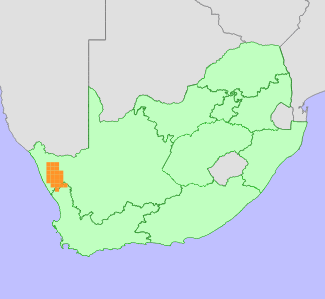|
Scientific Name | Conophytum pellucidum Schwantes subsp. pellucidum |
Higher Classification | Dicotyledons |
Family | AIZOACEAE |
Common Names | Bruintandjies (a) |
National Status |
Status and Criteria | Endangered A3c+4d |
Assessment Date | 2021/12/01 |
Assessor(s) | A.J. Young, P.G. Desmet, I. Ebrahim, D. Guo, A. Harrower, L. Jabar, L. Knoetze, C. Rodgerson, P.C.V. Van Wyk & N.N. Mhlongo |
Justification | This succulent is endemic to the Northern Cape province of South Africa with an extent of occurrence (EOO) of 8,241 km2 and area of occupancy (AOO) of 600 km2. The population is in decline due to illegal collection for the ornamental succulent plant trade, with collection likely to increase as there has been a dramatic increase in the number of species and volume of plants targeted since 2019. The broad distribution across numerous locations and large population size may limit the decline in population to no more than 45% over the next three generations (90 years). Modelling of climate change impacts is predicted to result in a loss of 57% of the population by 2080. An overall decline to the population of 50-60% of the population is possible within three generations. It therefore qualifies as Endangered under criteria A3 and A4. |
Distribution |
Endemism | South African endemic |
Provincial distribution | Northern Cape |
Range | This succulent is endemic to the Northern Cape province of South Africa where it is found in central Namaqualand. |
Habitat and Ecology |
Major system | Terrestrial |
Major habitats | Fynbos, Nama Karoo, Succulent Karoo |
Description | This succulent is primarily found in the Namaqualand Hardeveld bioregion of the Succulent Karoo biome (especially in Namaqualand Klipkoppe Shrubland). The plants often completely fill shallow grit pans on weathered gneiss and inhabit cracks and fissures on exposed rocks. This taxon has a generation length of 30 years. It is expected to be sensitive to the impacts of climate change as it does not disperse and while adapted to arid conditions, is dependent on limited seasonal rainfall. Species in the genus are sensitive to long periods of drought. Drought related mortality has been observed for other closely related taxa within the genus. |
Threats |
| This taxon is currently threatened by illegal collection for the international trade in ornamental succulents. Several thousand plants have been confiscated from poachers since 2019. This is likely to increase in future as there has been a dramatic increase in the number of species and volume of plants targeted since 2019. The distribution of this taxon primarily centres around an urban area which is likely to make it more susceptible to illegal collection. In addition, this variable taxon is especially popular in cultivation. As a result a population decline of 50-60% is suspected over three generations (90 years).
There is no decline in habitat quality for this succulent as inferred by changes in vegetation cover determined from changes in Enhanced Vegetation Index (EVI) between 1984 and 2018 using Landsat data (Venter et al. 2020). Anthropogenic climate change is however a long-term threat to this taxon. Climate models for the likely emission scenarios where emissions stay at present day levels (RCP 2.6) (Hausfather and Peters 2020) and worst case scenarios where emissions continue to increase during the 21st century (RCP 8.5) indicate that there will be a loss of suitable bioclimatic envelope of between 77% and 98% by 2080 for this succulent. However, as this taxon possesses certain morphological traits likely to afford resilience to xerophytic conditions and is found across several vegetation units it is expected to have a level of resilience to climate change and the expected population loss is reduced by 20% to 57%. Species in this genus have limited dispersal ability and migration to suitable habitats elsewhere is regarded as highly unlikely. |
Population |
This succulent usually occurs in small clusters of 10-100 plants but may be locally very abundant. There are no formal estimates of population size for this species but there are likely between 250,000 and 500,000 mature individuals. The population is in decline due to illegal collection for the ornamental succulent plant trade. At least 4,500 plants have been removed from habitat between 2019 and the end of 2021 based on confiscation records, with many more having likely been removed but not intercepted by law enforcers.
|
Population trend | Decreasing |
Assessment History |
Taxon assessed |
Status and Criteria |
Citation/Red List version | | Conophytum pellucidum Schwantes subsp. pellucidum var. pellucidum | Least Concern | Raimondo et al. (2009) | | Conophytum pellucidum Schwantes subsp. pellucidum var. lilianum (Littlew.) S.A.Hammer | Least Concern | Raimondo et al. (2009) | | Conophytum pellucidum Schwantes subsp. pellucidum var. terricolor (Tischer) Littlew. ex S.A.Hammer | Least Concern | Raimondo et al. (2009) | | Conophytum pellucidum Schwantes subsp. pellucidum var. neohallii S.A.Hammer | Least Concern | Raimondo et al. (2009) | |
Bibliography |
Hammer, S. 2002. Dumpling and his wife: New view of the genus Conophytum. EAE Creative Colour, Norwich.
Hammer, S.A. 1993. The genus Conophytum: A conograph. Succulent Plant Publications, Pretoria.
Hausfather, Z. and Peters, G.P. 2020. Emissions - the 'business as usual' story is misleading. Nature 577(618-620).
Opel, M.R. 2004. The rediscovery of Crassula alcicornis. Haseltonia 10:38-40.
|
Citation |
| Young, A.J., Desmet, P.G., Ebrahim, I., Guo, D., Harrower, A., Jabar, L., Knoetze, L., Rodgerson, C., Van Wyk, P.C.V. & Mhlongo, N.N. 2021. Conophytum pellucidum Schwantes subsp. pellucidum. National Assessment: Red List of South African Plants version 2024.1. Accessed on 2025/11/07 |
 Comment on this assessment
Comment on this assessment

